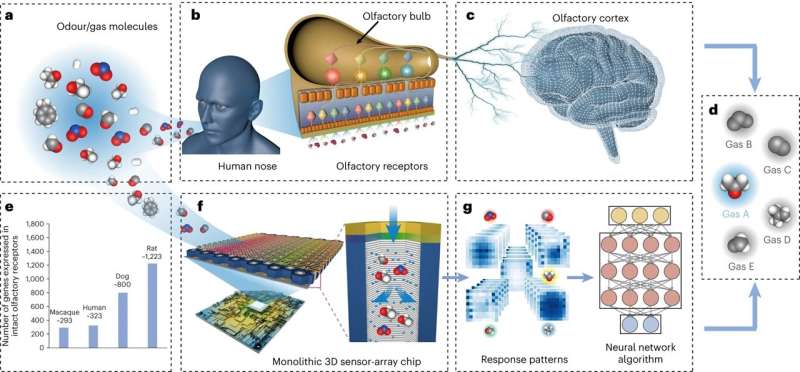
A research team led by the School of Engineering of the Hong Kong University of Science and Technology (HKUST) has addressed the long-standing challenge of creating artificial olfactory sensors with arrays of diverse high-performance gas sensors.
Their newly developed biomimetic olfactory chips (BOC) are able to integrate nanotube sensor arrays on nanoporous substrates with up to 10,000 individually addressable gas sensors per chip, a configuration that is similar to how olfaction works for humans and other animals.
For decades, researchers worldwide have been developing artificial olfaction and electronic noses (e-noses) with the aim of emulating the intricate mechanism of the biological olfactory system to discern complex odorant mixtures effectively. Yet, major challenges of their development lie in the difficulty of miniaturizing the system and increasing its recognition capabilities in determining the exact gas species and their concentrations within complex odorant mixtures.
To tackle these issues, the research team led by Prof. Fan Zhiyong, Chair Professor at HKUST's Department of Electronic & Computer Engineering and Department of Chemical & Biological Engineering, used an engineered material composition gradient that allows for wide arrays of diverse sensors on one small nanostructured chip.
Leveraging the power of artificial intelligence, their biomimetic olfactory chips exhibit exceptional sensitivity to various gases with excellent distinguishability for mixed gases and 24 distinct odors. With a vision to expand their olfactory chip's applications, the team also integrated the chips with vision sensors on a robot dog, creating a combined olfactory and visual system that can accurately identify objects in blind boxes.
The development of the biomimetic olfactory chips will not only improve the existing broad applications of the artificial olfaction and e-noses systems in food, environmental, medical, and industrial process control but also open up new possibilities in intelligent systems, such as advanced robots and portable smart devices, for applications in security patrols and rescue operations.
For example, in their applications in real-time monitoring and quality control, the biomimetic olfactory chips can be used to detect and analyze specific odors or volatile compounds associated with different stages of industrial processes to ensure safety, detect any abnormal or hazardous gases in environmental monitoring; and identify leakage in pipes to facilitate timely repair.
The technology presented in this study serves as a pivotal breakthrough in the realm of odor digitization. As the scientific community witnesses the triumphant prevalence of visual information digitization, facilitated by modern and mature imaging sensing technologies, the realm of scent-based information has yet remained untapped due to the absence of advanced odor sensors.
The work conducted by Prof. Fan's team has paved the way for the development of biomimetic odor sensors that possess immense potential. With further advancements, these sensors could find widespread utilization, akin to the ubiquitous presence of miniaturized cameras in cell phones and portable electronics, thereby enriching and enhancing people's quality of life.
A scholar in interdisciplinary materials science and engineering, Prof. Fan is keen on combining a practical approach with daring imagination in driving top-notch research that generates social impact. Working on biomimetic sensory systems for more than two decades, he first started with the visual system and successfully developed the world's first spherical artificial eye with a 3D retina in 2020. Riding on this success, he ventured into the olfactory system and elevated his work by integrating both systems to realize more intelligent robots with expanded applications.
"In the future, with the development of suitable bio-compatible materials, we hope that the biomimetic olfactory chip can also be placed on the human body to allow us to smell an odor that normally cannot be smelled. It can also monitor the abnormalities in volatile organic molecules in our breath and emitted by our skin, to warn us on potential diseases, reaching further potential of biomimetic engineering," said Prof. Fan.
The study is published in the journal Nature Electronics.
More information: Chen Wang et al, Biomimetic olfactory chips based on large-scale monolithically integrated nanotube sensor arrays, Nature Electronics (2024). DOI: 10.1038/s41928-023-01107-7
Citation: Researchers develop biomimetic olfactory chips to enable advanced gas sensing and odor detection (2024, March 28) retrieved 28 March 2024 from https://techxplore.com/news/2024-03-biomimetic-olfactory-chips-enable-advanced.html
This document is subject to copyright. Apart from any fair dealing for the purpose of private study or research, no part may be reproduced without the written permission. The content is provided for information purposes only.
